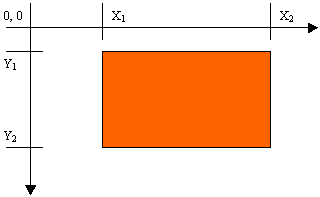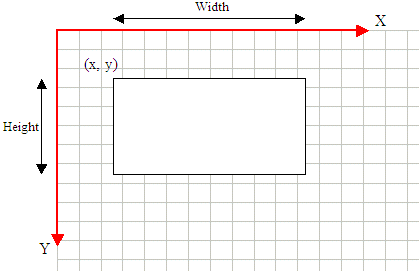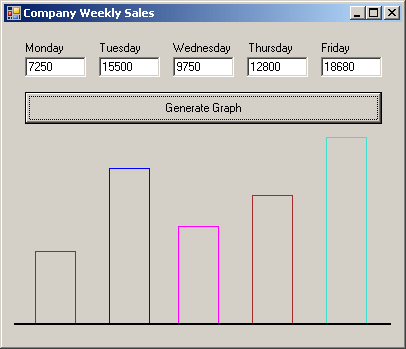
GDI+ Shapes: Rectangles and Squares
 |
GDI+ Shapes: Rectangles and Squares |
Introduction
A rectangle is a geometric figure made of four sides that compose four right angles. To draw a rectangle, you can either specify the Rectangle value that encloses it, or you can define its location and its dimensions. To draw a rectangle that is enclosed in a Rectangle value, you can use the following version of the Graphics.DrawRectangle() method:
public void DrawRectangle(Pen pen, Rectangle rect);
Remember that such a rectangle object can be illustrated as follows:

After defining a Rectangle variable, you can pass it to the method. Here is an example:
using System;
using System.Drawing;
using System.Windows.Forms;
public class Exercise : Form
{
public Exercise()
{
InitializeComponent();
}
void InitializeComponent()
{
Paint += new PaintEventHandler(Exercise_Paint);
}
private void Exercise_Paint(object sender, PaintEventArgs e)
{
Pen penCurrent = new Pen(Color.Red);
Rectangle Rect = new Rectangle(20, 20, 248, 162);
e.Graphics.DrawRectangle(penCurrent, Rect);
}
}
public class Program
{
public static int Main()
{
Application.Run(new Exercise());
return 0;
}
}
Remember that you can also define a Pen and/or a Rectangle objects in the parentheses of the method:
private void Exercise_Paint(object sender, PaintEventArgs e)
{
e.Graphics.DrawRectangle(new Pen(Color.Red),
new Rectangle(20, 20, 248, 162));
}
This would produce:

It is (very) important to remember that the third argument of the Rectangle represents its width (and not its right) value and the fourth argument represents its height (and not its bottom) value. This is a confusing fact for those who have programmed in GDI: GDI+ defines a Rectangle differently than GDI. In fact, to determine the location and dimensions of a rectangle to draw, the Graphics class provides the following versions of the DrawRectangle() method:
public void DrawRectangle(Pen pen, int x, int y, int width, int height); void DrawRectangle(Pen pen, float x, float y, float width, float height);
This time, the rectangle is represented by its location with a point at (x, y) and its dimensions with the width and height argument. This can be illustrated in a Windows coordinate system as follows:

Based on this, the earlier rectangle can also be drawn with the following:
private void Exercise_Paint(object sender, PaintEventArgs e)
{
e.Graphics.DrawRectangle(new Pen(Color.Red), 20, 20, 248, 162);
}
A square is a rectangle whose four sides are equal.
![]() Practical Learning: Drawing a Rectangle
Practical Learning: Drawing a Rectangle

| Control | Name | Text | |
| Label |
|
Monday | |
| Label |
|
Tuesday | |
| Label |
|
Wednesday | |
| Label |
|
Thursday | |
| Label |
|
Friday | |
| TextBox |
|
txtMonday | 0 |
| TextBox |
|
txtTuesday | 0 |
| TextBox |
|
txtWednesday | 0 |
| TextBox |
|
txtThursday | 0 |
| TextBox |
|
txtFriday | 0 |
| Button |
|
Generate | btnGenerate |
using System;
using System.Collections.Generic;
using System.ComponentModel;
using System.Data;
using System.Drawing;
using System.Linq;
using System.Text;
using System.Windows.Forms;
namespace WeeklySales1
{
public partial class Form1 : Form
{
private Graphics graphDrawingArea;
private Bitmap bmpDrawingArea;
public Form1()
{
InitializeComponent();
}
private void Form1_Load(object sender, EventArgs e)
{
bmpDrawingArea = new Bitmap(Width, Height);
graphDrawingArea = Graphics.FromImage(bmpDrawingArea);
}
}
}
private void Form1_Paint(object sender, PaintEventArgs e)
{
e.Graphics.DrawImage(bmpDrawingArea, 0, 0);
}
private void btnGenerate_Click(object sender, EventArgs e)
{
int monday= 0,
tuesday = 0,
wednesday = 0,
thursday = 0,
friday = 0;
try
{
monday = int.Parse(txtMonday.Text) / 100;
}
catch (FormatException)
{
MessageBox.Show("Invalid sales on Monday");
txtMonday.Text = "0";
}
try
{
tuesday = int.Parse(txtTuesday.Text) / 100;
}
catch (FormatException)
{
MessageBox.Show("Invalid sales on Tuesday");
txtTuesday.Text = "0";
}
try
{
wednesday = int.Parse(txtWednesday.Text) / 100;
}
catch (FormatException)
{
MessageBox.Show("Invalid sales on Wednesday");
txtWednesday.Text = "0";
}
try
{
thursday = int.Parse(txtThursday.Text) / 100;
}
catch (FormatException)
{
MessageBox.Show("Invalid sales on Thursday");
txtThursday.Text = "0";
}
try
{
friday = int.Parse(txtFriday.Text) / 100;
}
catch (FormatException)
{
MessageBox.Show("Invalid sales on Friday");
txtFriday.Text = "0";
}
graphDrawingArea.Clear(this.BackColor);
graphDrawingArea.DrawRectangle(new Pen(Color.Red),
this.txtMonday.Left + 10,
300 - monday,
40, monday);
graphDrawingArea.DrawRectangle(new Pen(Color.Blue),
this.txtTuesday.Left + 10,
300 - tuesday,
40, tuesday);
graphDrawingArea.DrawRectangle(new Pen(Color.Fuchsia),
this.txtWednesday.Left + 5,
300 - wednesday,
40, wednesday);
graphDrawingArea.DrawRectangle(new Pen(Color.Brown),
this.txtThursday.Left + 5,
300 - thursday,
40, thursday);
graphDrawingArea.DrawRectangle(new Pen(Color.Turquoise),
this.txtFriday.Left + 5,
300 - friday, 40, friday);
graphDrawingArea.DrawRectangle(new Pen(Color.Black),
10, 300, Width - 30, 1);
Invalidate();
}

A Series of Rectangles
The DrawRectangle() method is used to draw one rectangle. If you plan to draw many rectangles, you can proceed in one step by using the Graphics.DrawRectangles() method. It comes in two versions whose syntaxes are:
public void DrawRectangles(Pen pen, Rectangle[] rects); public void DrawRectangles(Pen pen, RectangleF[] rects);
This method requires an array of Rectangle or RectangleF values. When executed, it draws individual rectangles using each member of the array as its own rectangle. Here is an example:
private void Exercise_Paint(object sender, PaintEventArgs e)
{
Pen penCurrent = new Pen(Color.Red);
Rectangle[] Rect = { new Rectangle(20, 20, 120, 20),
new Rectangle(20, 50, 120, 30),
new Rectangle(20, 90, 120, 40),
new Rectangle(20, 140, 120, 60) };
e.Graphics.DrawRectangles(penCurrent, Rect);
}
This would produce:

|
|
||
| Home | Copyright © 2010-2021, FunctionX | |
|
|
||